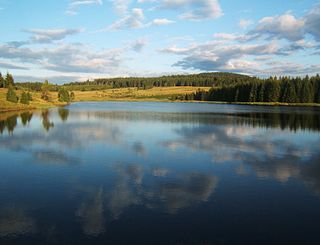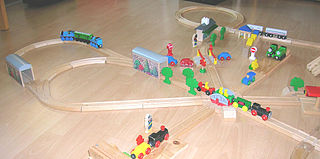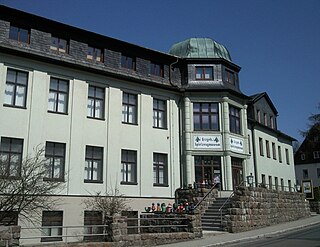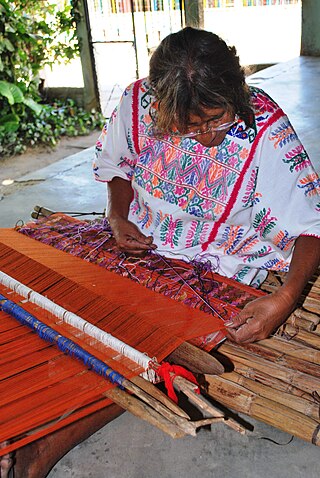Production
In the process known as Reifendrehen (literally "tyre turning" or “hoop turning”) a suitable piece of wood, as far as possible free of splits, is worked on a special wood lathe to produce a wooden ring with a diameter of about 30 to 50 centimetres, the cross-section of which forms the outline of the desired figure. Small slices are then sawn or split off the ring with a sharp knife. These are used as the raw material from which the finished figures are made by carving and painting.
The technique of Reifendrehen, which demands great experience and skill, emerged around 1800. It enabled, during the 19th century, the efficient mass production of wooden figures, because it was faster and cheaper than pure woodcarving by hand. Today part of the exhibition at the Ore Mountain Toy Museum in Seiffen is dedicated to the craft of the turners - the Reifendreher - who make these toys. In addition, there are several visitor workshops in the region around Seiffen.
The production of Reifendrehen animals in the Ore Mountain Open Air Museum, July 2009
Reifendrehen workshop
A turned wooden ring in the shape of a deer
Finishing touches
Production of turned animals (Seiffen, 1929)

A nutcracker is a tool designed to open nuts by cracking their shells. There are many designs, including levers, screws, and ratchets. The lever version is also used for cracking lobster and crab shells.

The Ore Mountains lie along the Czech–German border, separating the historical regions of Bohemia in the Czech Republic and Saxony in Germany. The highest peaks are the Klínovec in the Czech Republic at 1,244 metres (4,081 ft) above sea level and the Fichtelberg in Germany at 1,215 metres (3,986 ft).

Repoussé or repoussage ( ) is a metalworking technique in which a malleable metal is shaped by hammering from the reverse side to create a design in low relief. Chasing or embossing is a similar technique in which the piece is hammered on the front side, sinking the metal. The two techniques are often used in conjunction.

A Dalecarlian horse or Dala horse is a traditional carved, painted wooden statue of a horse originating in the Swedish province of Dalarna (Dalecarlia). In the old days the Dalecarlian horse was mostly used as a toy for children; in modern times it has become a symbol of Dalarna, as well as of Sweden in general. Several types of Dalecarlian horses are made, with distinguishing features common to the locality of the site where they are produced. One particular style has, however, become much more common and widespread than others. It is stoutly carved and painted bright red with details and a harness in white, green, yellow and blue.

Black-figure pottery painting, also known as the black-figure style or black-figure ceramic, is one of the styles of painting on antique Greek vases. It was especially common between the 7th and 5th centuries BCE, although there are specimens dating as late as the 2nd century BCE. Stylistically it can be distinguished from the preceding orientalizing period and the subsequent red-figure pottery style.

The town of Seiffen is located in the district of Erzgebirgskreis, which is in the central south of the Free State of Saxony in Germany. The earliest record of the town dates to 1324 when it was referred to as "Cynsifen".

A Schwibbogen is a decorative candle-holder from the Ore Mountains region of Saxony, Germany. The first metal schwibbogen was made in 1740 in Johanngeorgenstadt. The early candle arches consisted of a single forged piece of black metal which could be painted. The number of candles varies with the size of the arc, the original design holding eleven. In the UK candle arches or candle bridges are marketed, often just consisting of a simple wooden stepped arch with 7 electric candles. These are not strictly schwibbögen.

Wooden toy trains are toy trains that run on a wooden track system with grooves to guide the wheels of the rolling stock. While the trains, tracks and scenery accessories are made mainly of wood, the engines and cars connect to each other using metal hooks or small magnets, and some use plastic wheels mounted on metal axles. Some trains are made to resemble anthropomorphical, fictional, and prototypical railroad equipment.

A toy museum is a museum for toys. They typically showcase toys from a particular culture or period with their history. These are distinct from children's museums, which are museums for children, and are often interactive – toy museums may be aimed at children or adults, and may have interactive exhibits or be exclusively for display.

San Martín Tilcajete is a town and municipality located about 23 kilometres (14 mi) from the city of Oaxaca, in the state of Oaxaca, in the south of Mexico. It is part of the Ocotlán District in the south of the Valles Centrales Region

Ceramics in Mexico date back thousands of years before the Pre-Columbian period, when ceramic arts and pottery crafts developed with the first advanced civilizations and cultures of Mesoamerica. With one exception, pre-Hispanic wares were not glazed, but rather burnished and painted with colored fine clay slips. The potter's wheel was unknown as well; pieces were shaped by molding, coiling and other methods,

The Ore Mountain Toy Museum in Seiffen is an internationally known museum of Ore Mountain toys and Ore Mountain folk art. It was opened in 1953 in Seiffen. In 1973 it was joined by the Ore Mountains Open-Air Museum, a folk art and local historic museum with 14 houses typical of the Ore Mountains before 1900 on the edge of the toy village.

Ore Mountain folk art is a well-known form of highly artistic wood carving from East Germany. It encompasses the diverse forms of expression of the creative work beyond the classical or the modern arts, and in particular the production of figures, sculptures and paintings. In a broader sense, the people's poetry, literature, and the Ore Mountain songs are in itself the folk art. The Ore Mountains claim to be the largest, enclosed folk art area in Germany.

The history of wooden toymaking in the Ore Mountains is closely bound to regional circumstances. The Ore Mountains are located in Central Europe on the border between Germany and the Czech Republic. For many centuries it was a countryside in which the local population eked out a hard existence from the land. Long and harsh winters restricted agriculture; in addition the region had very poor communications. With the onset of ore mining a new line of commerce developed, but the hard labour and high risks involved meant that it was only work for young and strong men. Many were injured or died as a result of accidents. The miners rose early in the morning whilst it was still dark in order to go to work and did not return home again until late in the evening after dark. From those times comes a custom that has survived to the present day, the practice of placing lights in the window. These lights were intended to show the miners the safe way back to the homes of their families.

The handcrafts of Guerrero include a number of products which are mostly made by the indigenous communities of the Mexican state of Guerrero. Some, like pottery and basketry, have existed relatively intact since the pre Hispanic period, while others have gone through significant changes in technique and design since the colonial period. Today, much of the production is for sale in the state's major tourism centers, Acapulco, Zihuatanejo and Taxco, which has influence the crafts’ modern evolution. The most important craft traditions include amate bark painting, the lacquerware of Olinalá and nearby communities and the silverwork of Taxdo.

The Glassworks Museum of the Ore Mountains is located in the old socage vault (Fronfeste) of Purschenstein Castle in Neuhausen/Erzgeb. in the German Free State of Saxony.

Jalisco handcrafts and folk art are noted among Mexican handcraft traditions. The state is one of the main producers of handcrafts, which are noted for quality. The main handcraft tradition is ceramics, which has produced a number of known ceramicists, including Jorge Wilmot, who introduced high fire work into the state. In addition to ceramics, the state also makes blown glass, textiles, wood furniture including the equipal chair, baskets, metal items, piteado and Huichol art.

Nutcracker dolls, also known as Christmas nutcrackers, are decorative nutcracker figurines most commonly made to resemble a toy soldier. In German tradition, the dolls are symbols of good luck, frightening away malevolent spirits. While nearly all nutcrackers from before the first half of the 20th century are functional, a significant proportion of modern nutcrackers are primarily decorative, and not able to crack nuts.

Christmas angels are small wooden figures portraying angels often playing an instrument. They can be arranged to an entire orchestra. The origins of artistic angel carving lie in the Ore Mountains where the angels are an integral part of Ore Mountain folk art.























